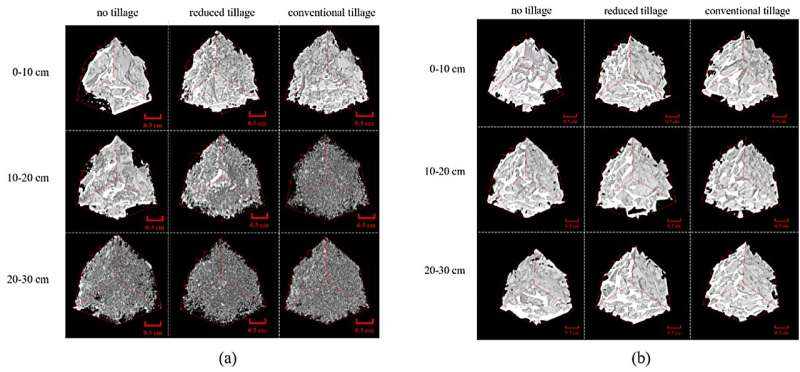This article has been reviewed according to Science X's editorial process and policies. Editors have highlighted the following attributes while ensuring the content's credibility:
fact-checked
trusted source
proofread
Pore structure characteristics found to influence carbon mineralization under conservation tillage

Soil aggregates are the basic units of soil structure and serve as a reservoir for soil carbon, playing a crucial role in the carbon cycle of ecosystems. The pore characteristics of soil aggregates influence the mineralization of soil organic carbon. However, research on the mechanisms of soil organic carbon sequestration at the aggregate level in Mollisols is limited.
Recently, a research team led by Prof. Liu Xiaobing and Prof. Zhang Xingyi from the Key Laboratory of Black Soils Conservation and Utilization, Northeast Institute of Geography and Agroecology of the Chinese Academy of Science revealed that pore connectivity and anisotropy affect carbon mineralization via extracellular enzymes in > 2 mm aggregates under conservation tillage of Mollisols.
The work was published in Soil and Tillage Research.
The study is based on a long-term location experiment of conservation tillage established at Hailun Station in 2004, selecting three treatments for research: conventional tillage, reduced tillage, and no tillage.
Industrial nanoscale computed tomography technology was used to measure the soil pore size distribution, shape parameters, extracellular enzyme activities, and carbon mineralization of situ soil columns and > 2 mm aggregate-filled soil columns .
Results showed that long-term no tillage and reduced tillage increased the total porosity and proportion of larger pores, but significantly decreased the proportion of smaller pores in situ soil columns.
Conventional tillage exhibited the most complex pores because of the highest pore fractal dimension (2.75–2.90), anisotropy (0.366–0.516), and the lowest sphericity (5.1–28.7) (figure 1a). As for the soil columns filled with > 2 mm aggregates, reduced tillage significantly increased the pore connectivity by 3.02–3.62 %, whereas no tillage had no effect (figure 1b).
Furthermore, the structural equation modeling indicated that in soil columns filled with > 2 mm aggregates, pore shape parameters, particularly connectivity and anisotropy, positively influenced the activities of β-glucosidase and β-xylosidase directly, and positively affected soil carbon mineralization by influencing extracellular enzymes activity indirectly.
The findings emphasize the importance of pore shape parameters effect on soil carbon sequestration, and will be helpful in comprehending the microscopic mechanisms of soil carbon sequestration in > 2 mm aggregates.
More information: Yang Xiao et al, Pore connectivity and anisotropy affect carbon mineralization via extracellular enzymes in > 2 mm aggregates under conservation tillage of Mollisols, Soil and Tillage Research (2024). DOI: 10.1016/j.still.2024.106253
Provided by Chinese Academy of Sciences



















